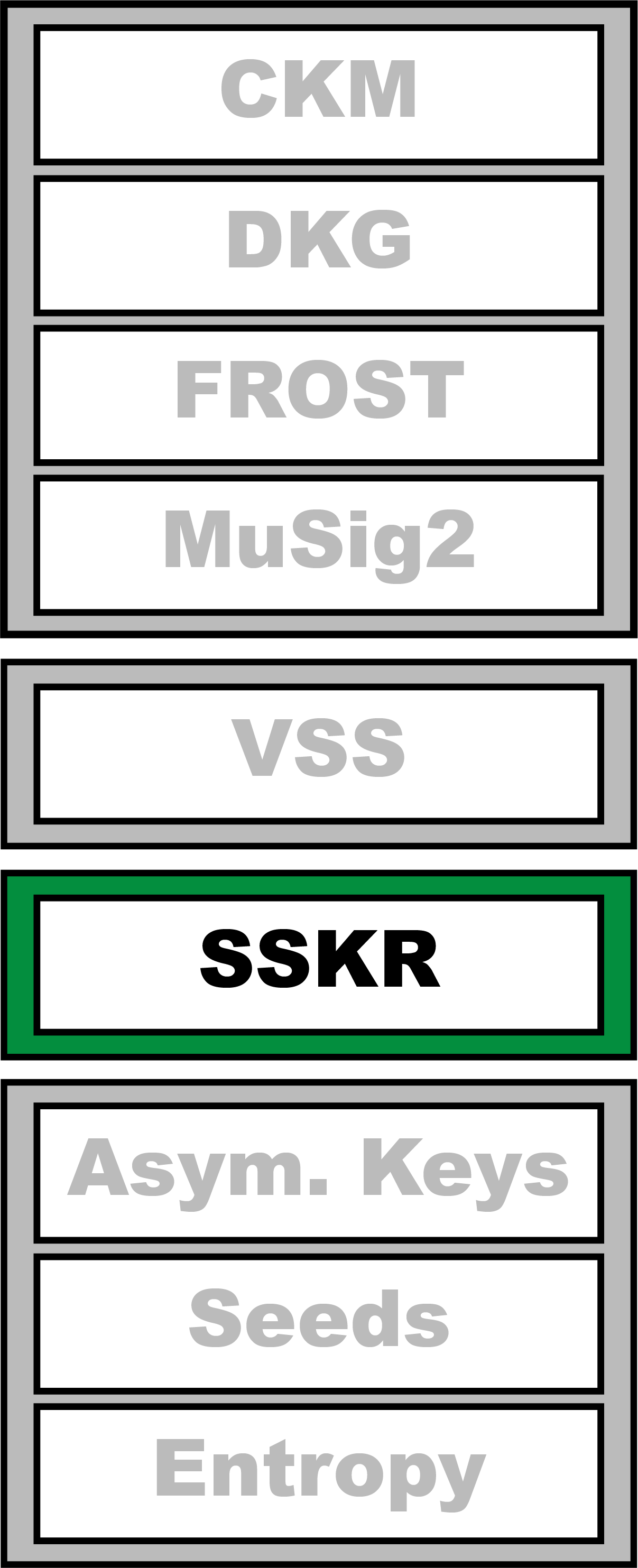Overview
SSKR is Sharded Secret Key Reconstruction. It’s a way that you can divide (“shard”) a seed (which is to say a secret, often used as the foundation for Hierarchical Deterministic, “HD”, wallet) into “shares”, which a user can then distribute to friends, family, or fiduciaries. If the user ever loses their seed, they can then “reconstruct” it by collecting sufficient of the shares (the “threshold”).
Why is SSKR Important?
One of the biggest challenges in the control of digital assets (particularly the self-sovereign control of digital assets) is Resilience It’s too easy for a user to lose the seed or key that control their assets, and thus the assets.
SSKR resolves the Single Point of Failure (SPOF) represented by a seed by allowing a backup of the seed to be created in a way that doesn’t introduce a Single Point of Compromise (SPOC) to the system. It does so by using Shamir’s Secret Sharing to shard a secret, with the intent being that the shares are then placed in discrete, remote locations. The seed can only be recovered if a sufficient threshold of shares are then combined.
How Does SSKR Work?
The basic level of SSKR allows you to create a single group of shares, with a threshold for how many of those must be collected to reconstruct the seed. The following shows an example from Gordian SeedTool of creating three shares, of which two must be recovered.

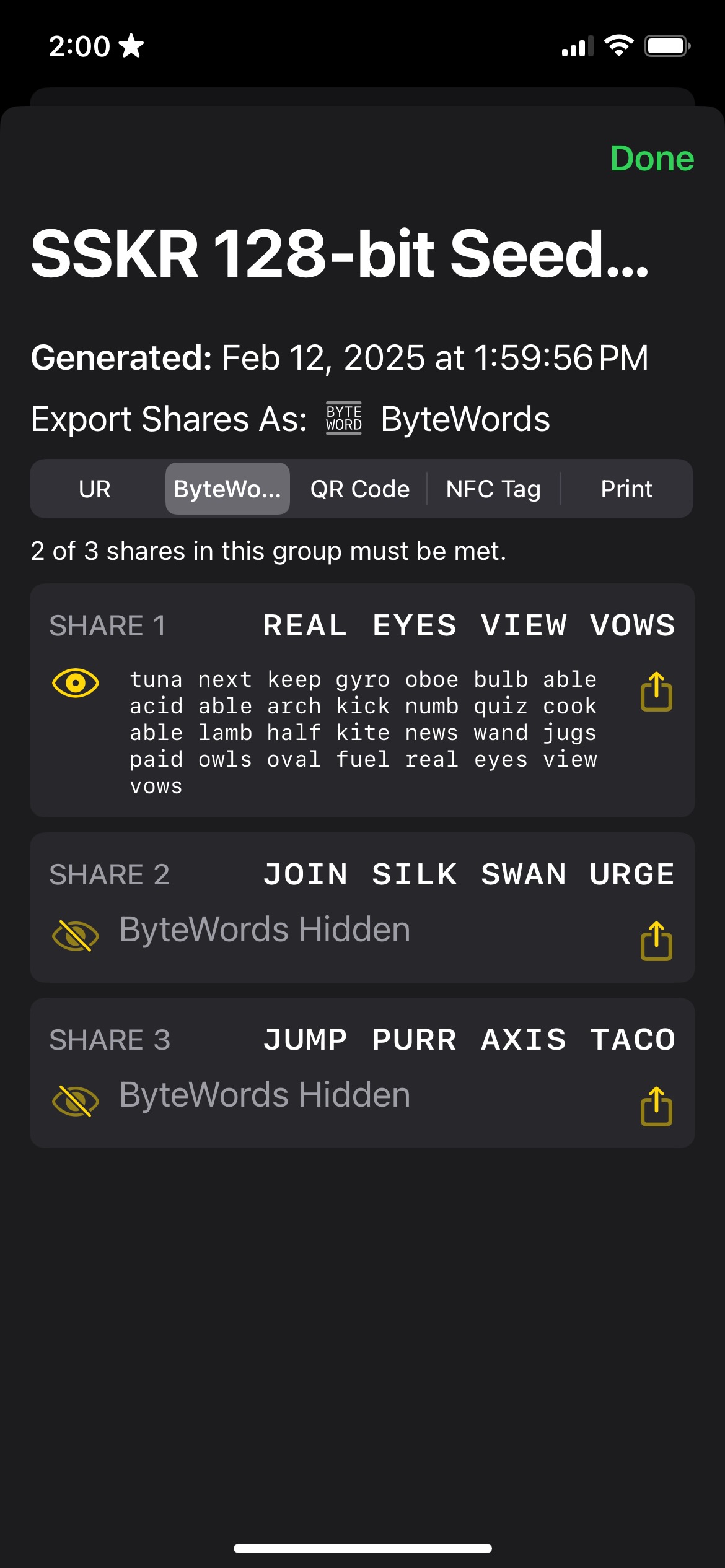
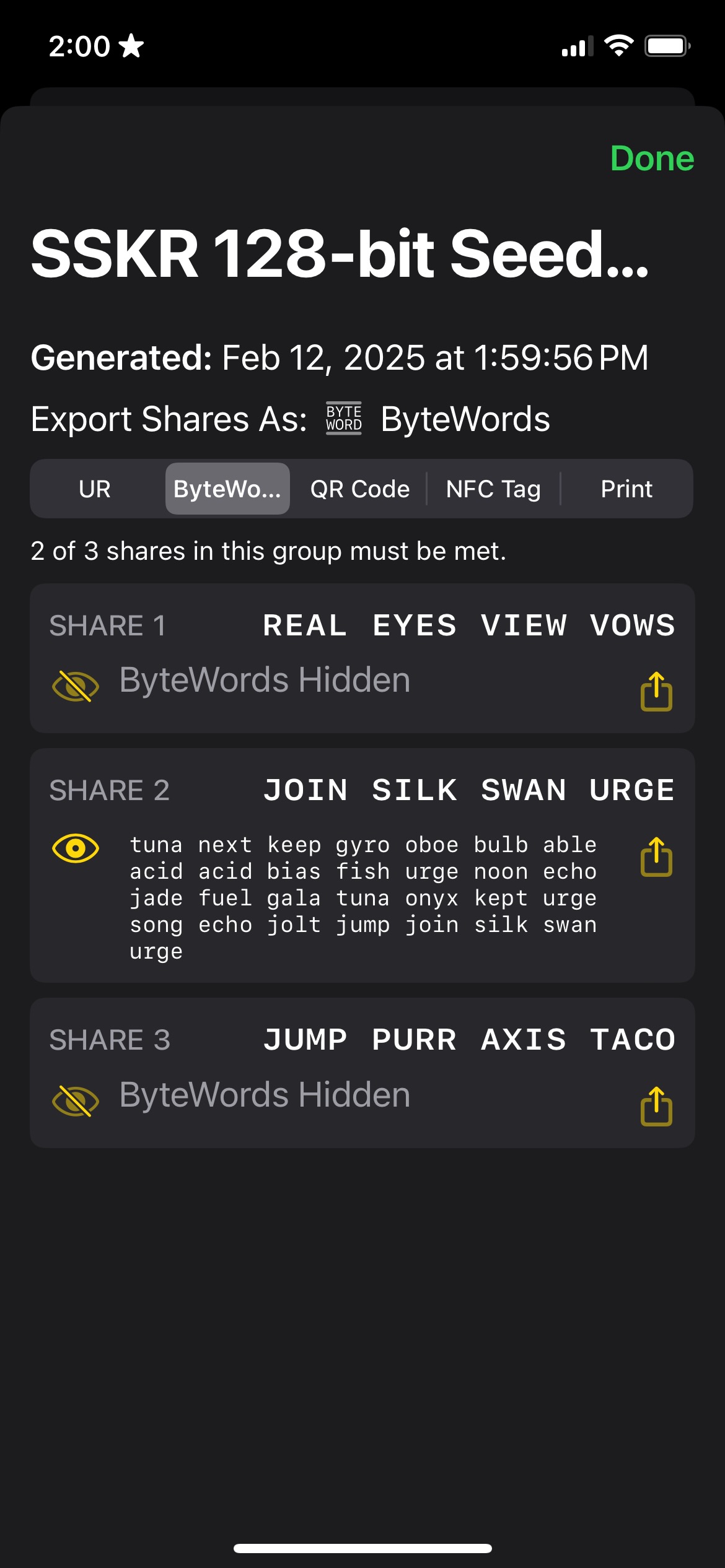
The user would take these shares and give one each to three different trusted people (or places, such as a safe or bank vault). (Or, this could be automated using CSR.)
See the SSKR FAQ for a more complete explanation of these words.
How Does Advanced SSKR Work?
SSKR supports a more advanced methodology where you can define multiple groups, and then require a certain number of shares to come back from each group for a certain number of groups.
The following shows an example from Gordian SeedTool where 2 of 3 shares must come back from 2 of 3 groups.
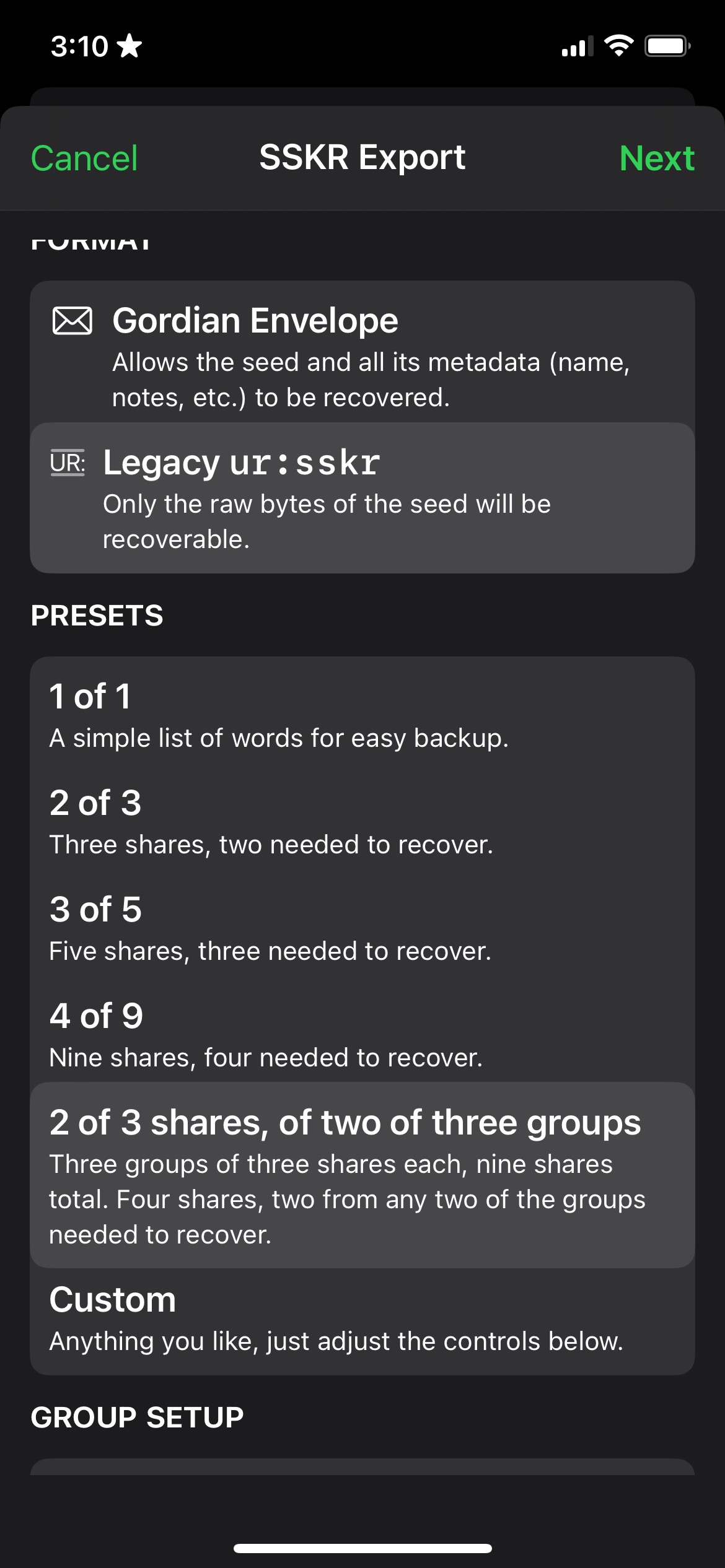
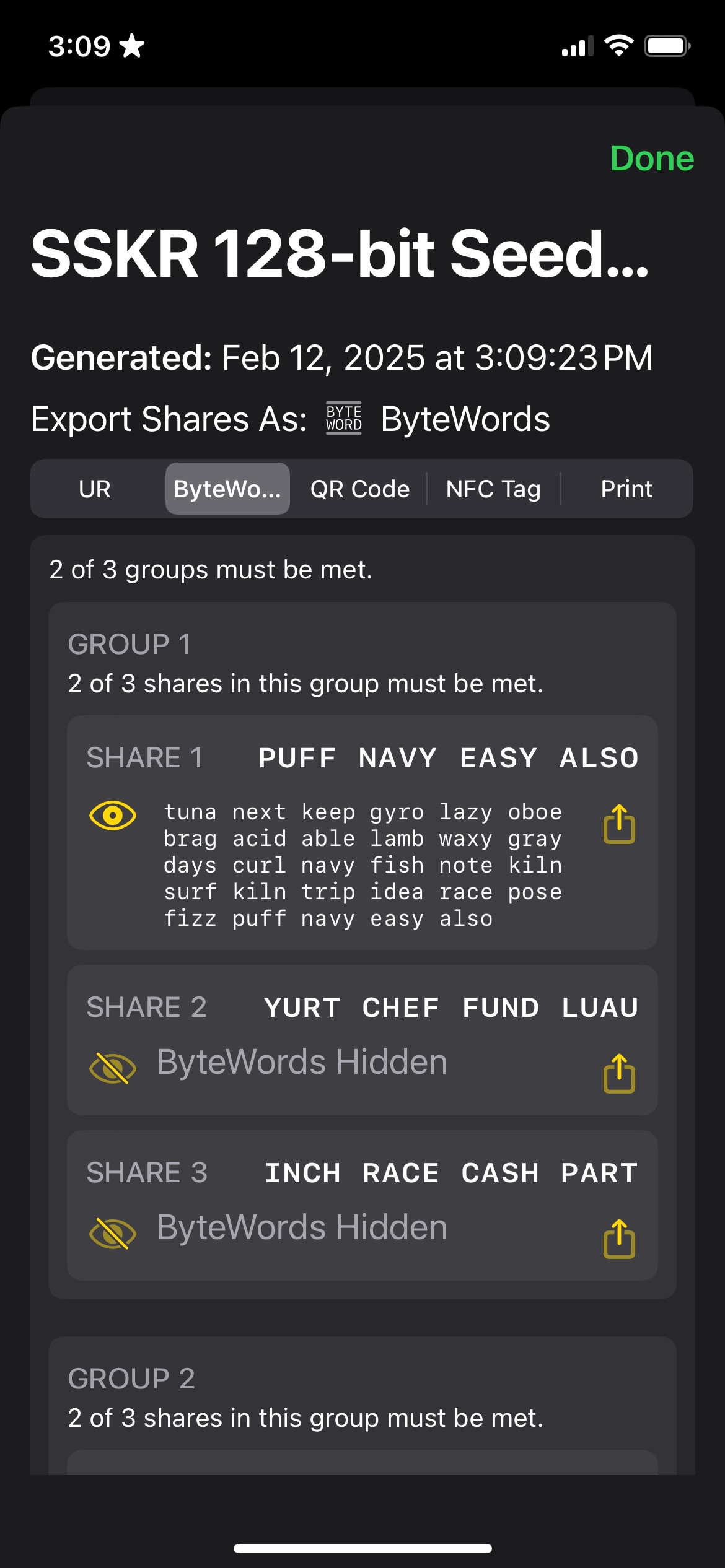
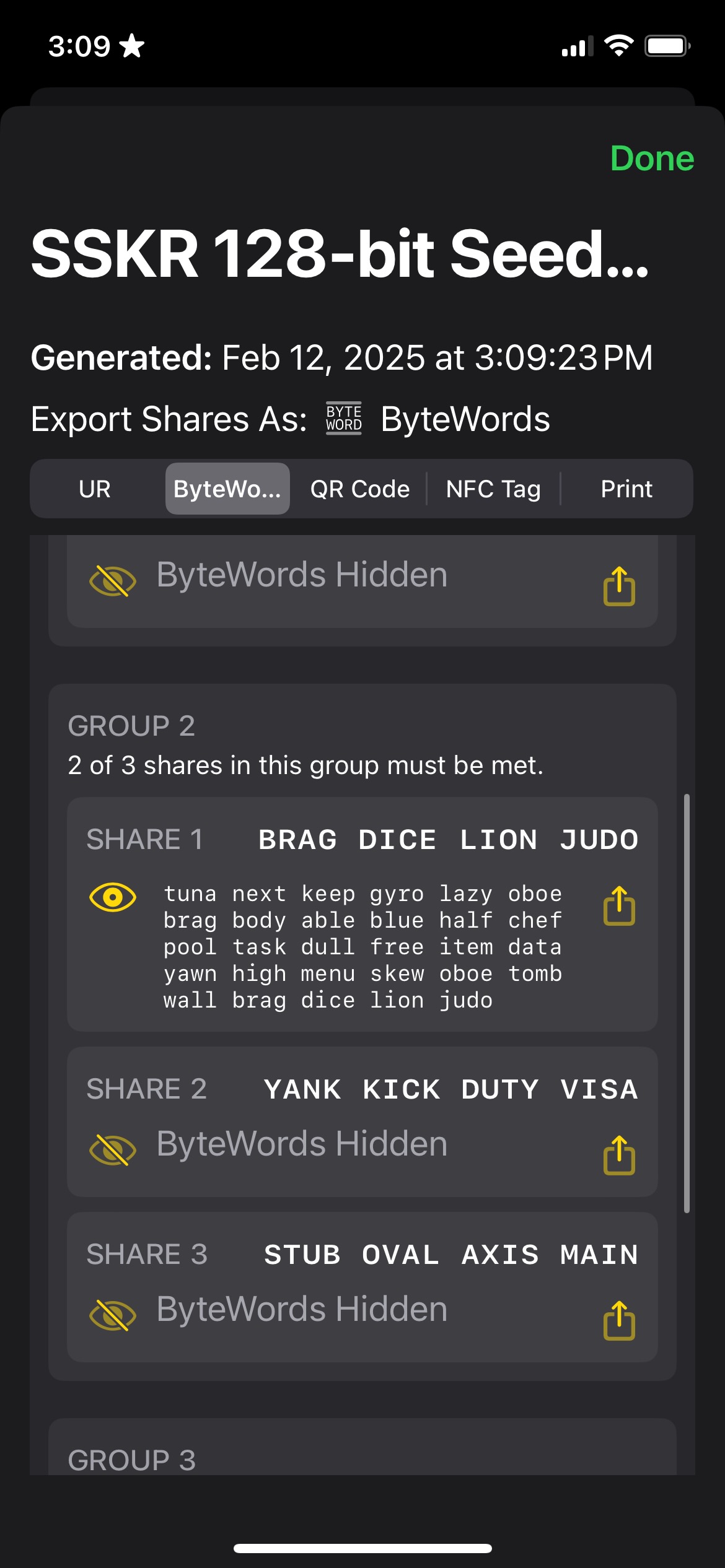
This can allow for more complex scenarios, such as a business that hands off one set of three shares to Chief Officers, and then backs that up with a set of three shares held by their accountants and another set of three shares held by some other fiduciary. Any two of the COs, accountants and fidicuaries could then recover using two of three shares from their sets—but not just any four shares, they have to come from two discrete groups.
(Though this example is symmetrical, that’s not required. You could require 2 of 3 shares from the CO group, 3 of 5 from the accountants, and 1 of 1 from the fidicuary, representing different levels of trust and different hierarchies within each group.)
Once you generate advanced SSKR shares, the user would distribute them just like basic SSKR shares, but here they’d need to be very careful to understand the roles of everyone they’ree giving shares to, since they’re creating a more complex procedure.
What are SSKR URs?
The above examples show SSKR being encoded with Uniform Resources. As described in BCR 2020-011, each share is converted to CBOR and prefixed with a ur:sskr tag. This supports the storage of shares in a self-identifying manner.
This is the simplest way to use SSKR, though not the preferred one: it’s generally been deprecated to instead prefer SSKR Envelopes.
What are SSKR Envelopes?
Envelope is Blockchain Commons’ privacy-focused format for the storage and transmission of data. Though the UR format supported the self-identifying storage of singular bits of data, Envelope goes further, allowing for the storage of multiple types of data, including metadata, allowing the preservation of multiple secrets and of descriptions of those secrets. (There are also many other advantages, as discussed on the Envelope page.)
To allow this, SSKR Envelopes takes a somewhat different tack from SSKR URs. You don’t shard your seed, key, or other secret. Instead you:
- Place your seed or key in an Envelope. Maybe multiple seeds or keys. Maybe multiple seeds or keys with metadata.
- Generate a new symmetric key.
- Use the new symmetric key to encrypt the Envelope containing your data.
- Shard the symmetric key with SSKR.
- Distribute copies of the Envelope that each contain the encrypted sub-Envelope and one of the shares of the symmetric key.
By this methodology, you can store many seeds and many keys in a single Envelope, but still only have one share to manage. You can also include metadata explaining what the seed or key is for, either inside or outside the encrypted content. (Encrypted metadata might remind you what a key is for; unecrypted metadata might help you or your heirs to recover sufficient key shares.) This method is much more in tune with the way that secrets work in the real world, where you may have many seeds for many different devices, and even old master keys generated without seeds.
Though SSKR Envelopes are our preferred way to encode and share secrets, you might use SSKR URs if you had a very constrained device or a very simple use case. The test vectors page includes examples of both.
How to Get Started with SSKR Envelopes
You can easily incorporate SSKR URs into your project by using an appropriate SSKR library to shard your seed or other secret.
However, we now suggest the use of SSKR Envelope instead, to allow the storage of metadata and multiple secrets. The following steps will allows you test out the integration of SSKR Envelopes into your system. First, create a solid foundation for storing Seeds in Envelopes:
- Add support for LifeHash for seeds in your UX, so that you can visually recognize seeds, making it easy to see when they have been reconstructed (or just transferred) correctly.
- Get started with Envelopes, as discussed on the Envelope dev page.
- Create a basic
ur:envelopecontaining your seed, adding notes and dates as metadata. You can use our 128-bit or 256-bit test seed for this purpose. - Test by reading your seed back. Throw out data that you don’t need when you do so.
- Test by outputting your Envelope as a QR and reading that back in.
- Test by outputting your Envelope as an Animated QR and reading that back in.
At this point you should have seeds that you know are interoperable thanks to the ability to check with LifeHash and the successful export and import in a variety of formats. You can now integrate SSKR as well:
- Integrate SSKR and export an SSKR Envelope of your seed as a 2-of-3 sharding.
- Test import with each of three combinations of two shares: AB, BC, and AC.
- Test a two-of-three group, 2-of-3 share sharding, and import with a few different combination of two shares from two different groups, such as: A1A2B1B2, A2A3C2C3, and A1A3B2B3.
- Figure out what other metadata you’d like to include, such as seed name, seed creation date, and notes. Export your seed with this metadata, shard, and reconstruct.
Videos
|
SSKR in Overview:
|
Early Demo Video:
|
SSKR & Envelope:
|
Libraries
Shamir’s Secret Sharing Libraries
| Language | Repo | Contributor | Status |
|---|---|---|---|
| C | bc-shamir | Blockchain Commons | Security Reviewed |
| Java | bc-libs-java | Bitmark | |
| Rust | bc-shamir-rust | Blockchain Commons | |
| Swift | BCLibsSwift | Blockchain Commons | |
| TypeScript | shamir | Leonardo Custodio |
SSKR Libraries
| Language | Repo | Contributor | Status |
|---|---|---|---|
| C | bc-sskr | Blockchain Commons | Security Reviewed |
| Java | bc-libs-java | Bitmark | |
| JavaCard | jc-sskr | Proxy | |
| Rust | bc-sskr-rust | Blockchain Commons | |
| Swift | BCLibsSwift | Blockchain Commons | |
| TypeScript | sskr | Leonardo Custodio |
Envelope Libraries
| Language | Repo | Contributor | Status |
|---|---|---|---|
| Rust | bc-envelope-rust | Blockchain Commons | |
| Swift | BCSwiftEnvelope | Blockchain Commons | |
| TypeScript | envelope | Leonardo Custodio |
Links
Intro:
- Shamir’s Secret Sharing: An Overview (#RWOT9)
- BCR-011: UR Type Definition for SSKR (Blockchain Commons Research)
- SSKR Lexicon
Developer Resources:
Developer Reference Apps:
- Gordian SeedTool (app implementation)
- SeedTool CLI (CLI implementation)
- Ledger Seed Tool App (app implementation by Aido)
Use Cases:
Other Resources:
- Designing SSKR Share Scenarios (#SmartCustody)
- SSKR Dangers (#SmartCustody)
- Evaluating Social Schemes for Recovery (#RWOT8)
